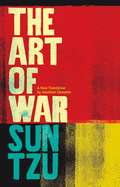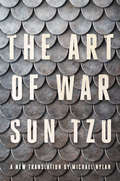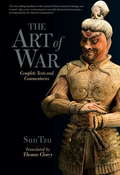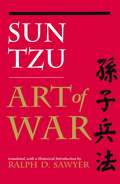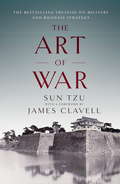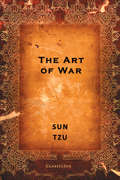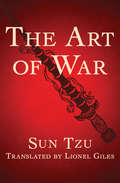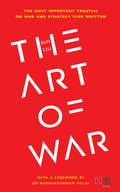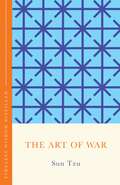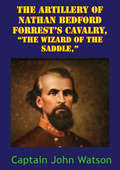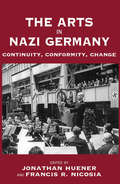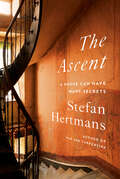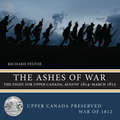- Table View
- List View
The Art of War in an Age of Peace: U.S. Grand Strategy and Resolute Restraint
by Michael O'HanlonAn informed modern plan for post-2020 American foreign policy that avoids the opposing dangers of retrenchment and overextension Russia and China are both believed to have “grand strategies”—detailed sets of national security goals backed by means, and plans, to pursue them. In the United States, policy makers have tried to articulate similar concepts but have failed to reach a widespread consensus since the Cold War ended. While the United States has been the world’s prominent superpower for over a generation, much American thinking has oscillated between the extremes of isolationist agendas versus interventionist and overly assertive ones. Drawing on historical precedents and weighing issues such as Russia’s resurgence, China’s great rise, North Korea’s nuclear machinations, and Middle East turmoil, Michael O’Hanlon presents a well†‘researched, ethically sound, and politically viable vision for American national security policy. He also proposes complementing the Pentagon’s set of “4+1” pre†‘existing threats with a new “4+1”: biological, nuclear, digital, climatic, and internal dangers.
The Art of War: A New Translation
by Jonathan ClementsA new translation for the 21st century.The Art of War by Sun Tzu is one of the most influential political and business books of our era. This gateway edition for the 21st century reader rediscovers the essential clarity of the ancient masterpiece, cited by generals from a dozen Chinese dynasties, international business leaders, and modern military field manuals.This edition also contains a full commentary on Sun Tzu, the man and his ideas, contemporary of Confucius and Buddha; and a critical guide to further reading. This is the perfect introduction to one of the world's best-known classics.
The Art of War: A New Translation
by Jonathan ClementsA new translation for the 21st century.The Art of War by Sun Tzu is one of the most influential political and business books of our era. This gateway edition for the 21st century reader rediscovers the essential clarity of the ancient masterpiece, cited by generals from a dozen Chinese dynasties, international business leaders, and modern military field manuals.This edition also contains a full commentary on Sun Tzu, the man and his ideas, contemporary of Confucius and Buddha; and a critical guide to further reading. This is the perfect introduction to one of the world's best-known classics.
The Art of War: A New Translation By Michael Nylan
by Sun TzuFor the first time in any modern language, a female scholar and translator reimagines The Art of War. Sun Tzu’s ancient book of strategy and psychology has as much to tell us today as when it was first written 2,500 years ago. In a world forever at odds, his rules for anticipating the motivations and strategies of our competitors never cease to inspire leaders of all kinds. Michael Nylan, in her provocative introduction, sees new and unexpected lessons to be learned from The Art of War—in business ventures, relationships, games of skill, academic careers, and medical practices. Strategy, like conflict, is woven into society’s very roots. Nylan’s crisp translation “offers a masterly new evaluation of this classic work, which balances the overtly military content with a profound and thought-provoking analysis” (Olivia Milburn). Readers newly engaging with ancient Chinese culture will be inspired by Nylan’s authoritative voice. Informed by years of scholarly study, Nylan is uniquely placed to introduce readers to Sun Tzu’s classic work through her detailed annotations on culture and the intricacies of translating ancient Chinese into modern English. She proves that Sun Tzu is more relevant than ever, helping us navigate the conflicts we know and those we have yet to endure.
The Art of War: Complete Text and Commentaries
by Thomas ClearyConflict is an inevitable part of life, according to this ancient Chinese classic of strategy, but everything necessary to respond to conflict wisely, thoroughly, and victoriously is right before us at all times. The key to skillful action in any situation is in knowing those things that make up the environment and then seeing the patterns they form so that their power becomes available to us. It is not necessary to change the nature of things to find victory. Since, as Sun Tzu teaches, aggression and response in kind can lead only to destruction, we must learn to work with conflict in a more profound and effective way. The Art of War shows us how. The Art of War gives us proven strategic skills to apply when we need to take action and overcome obstacles in rapidly changing, chaotic situations. Though ancient in origin, these strategies are accessible because they are based on the ways we already do things. As Sun Tzu shows, rather than getting mired in conflict, we can create momentum and bring about the tipping point to achieve success.
The Art of War: Complete Texts and Commentaries (Shambala Pocket Classics Ser.)
by Sun Tzu Thomas ClearySun Tzu's Art of War, compiled more than two thousand years ago, is a study of the anatomy of organizations in conflict. It is perhaps the most prestigious and influential book of strategy in the world today. Now, this unique volume brings together the essential versions of Sun Tzu's text, along with illuminating commentaries and auxiliary texts written by distinguished strategists. The translations, by the renowned translator Thomas Cleary, have all been published previously in book form, except for The Silver Sparrow Art of War, which is available here for the first time. This collection contains:The Art of War: This edition of Sun Tzu's text includes the classic collection of commentaries by eleven interpreters.Mastering the Art of War: Consisting of essays by two prominent statesmen-generals of Han dynasty China, Zhuge Liang and Liu Ji, this book develops the strategies of Sun Tzu's classic into a complete handbook of organization and leadership. It draws on episodes from Chinese history to show in concrete terms the proper use of Sun Tzu's principles.The Silver Sparrow Art of War: A version of Sun Tzu's Art of War based on a manuscript of the classic text discovered at a Chinese archeological site in China's Shandong Province in 1972, which contains previously unknown fragments.Note: The electronic edition of this book does not contain The Lost Art of War, as seen in the paperback edition.
The Art of War: Large Print (Vintage Classics)
by Sun TzuA new translation of the ancient Chinese military classic that is widely admired by military and business strategists—with an introduction that provides sweeping historical context, and notes featuring contemporary commentary on Sun Tzu's wisdom over the centuries.For more than two thousand years, The Art of War has provided leaders with essential tactical and management advice. An elemental part of Chinese culture, it has also become a touchstone in the West for achieving success, whether on the battlefield or in business. This Vintage Classics edition features a brilliant translation by Peter Harris, first published by Everyman's Library in 2018. Alongside the pithy and powerful ancient text, Harris includes: • Notes • A bibliography • A chronology of Chinese dynasties • A map • Extracts from the canon of classical Chinese commentators • An illuminating introduction on the warrior-philosopher Sun Tzu and the role of The Art of War in history and today
The Art of War: Sun Tzu/sun Pin
by Sun Tzu Ralph D SawyerThe Art of War is almost certainly the most famous study of strategy ever written and has had an extraordinary influence on the history of warfare. The principles Sun-tzu expounded were utilized brilliantly by such great Asian war leaders as Mao Tse-tung, Giap, and Yamamoto. First translated two hundred years ago by a French missionary, Sun-tzu's Art of War has been credited with influencing Napoleon, the German General Staff, and even the planning for Desert Storm. Many Japanese companies make this book required reading for their key executives. And increasingly, Western businesspeople and others are turning to the Art of War for inspiration and advice on how to succeed in competitive situations of all kinds. Unlike most editions of Sun-tzu currently available (many simply retreads of older, flawed translations), this superb new translation makes use of the best available classical Chinese manuscripts, including the ancient "tomb text" version discovered by archaeologists at Linyi, China. Ralph Sawyer, an outstanding Western scholar of ancient Chinese warfare and a successful businessman in his own right, places this classic work of strategy in its proper historical context. Sawyer supplies a portrait of Sun-tzu's era and outlines several battles of the period that may have either influenced Sun-tzu or been conducted by him. While appreciative of the philosophical richness of the Art of War, this edition stresses Sun-tzu's practical origins and presents a translation that is both accurate and accessible.
The Art of War: Sun Zi's Military Methods (Translations from the Asian Classics)
by Sun ZiCompiled during the Warring States period of 475-221 B.C.E., The Art of War has had an enormous impact on the development of Chinese military strategy over the past two thousand years and occupies an important place in East Asian intellectual history. It is the first known attempt to formulate a rational basis for the planning and conduct of military operations, and while numerous editions of the work exist, Victor Mair's translation is the first to remain true to the original structure and essential style of the text. <P><P>Mair's fidelity to the original, along with his insightful commentary and reliance on archaeologically recovered manuscripts, breaks new ground in solving The Art of War's difficult textual and contextual problems. He confronts complex questions concerning the authorship of the work, asserting that Sun Wu, a supposed strategist of the Spring and Autumn period (770-476 B.C.E.) to whom the text is traditionally attributed, never existed. Instead, Mair claims that The Art of War coalesced over a period of around seventy-five years, from the middle of the fourth century to the first quarter of the third century B.C.E. Mair also reveals the way The Art of War reflects historical developments in technological and military strategy in civilizations throughout Eurasia, especially in regards to iron metallurgy. He demonstrates the close link between the philosophy in The Art of War and Taoism and discusses the reception of the text from the classical period to today. <P><P> Finally, Mair highlights previously unaddressed stylistic and statistical aspects and includes philological annotations that present new ways of approaching the intellectual and social background of the work. A phenomenal achievement, Mair's comprehensive translation is an indispensable resource for today's students, strategists, and scholars.
The Art of War: The Bestselling Treatise on Military & Business Strategy, with a Foreword by James Clavell
by James Clavell Sun TzuSun Tzu was one of the greatest army generals who ever lived. He wrote The Art of War in the fifth century BC and yet his words are still resoundingly relevant to our modern lives. His writings on aspects of warfare from the laying of plans to the tactics and psychology of manoeuvering an army, to the proper use of spies, resonate for us in today's world of cut-throat, ruthless business. With James Clavell's insightful foreword and notes, this classic is widely seen as a necessity on the bookshelf of military leaders and boardroom executives alike.
The Art of War: The Essential Translation Of The Classic Book Of Life (Penguin Modern Classics Series #909)
by Sun TzuAn ancient Chinese military text, The Art of War is a strategic and intellectual examination of the different aspects of warfare, and has served as a foundation of military doctrine from ancient to modern times. With discussions ranging from the use of force to civilian casualties, The Art of War continues to be a relevant and insightful treatise on military engagement.Be it mystery, romance, drama, comedy, politics, or history, great literature stands the test of time. ClassicJoe proudly brings literary classics to today's digital readers, connecting those who love to read with authors whose work continues to get people talking. Look for other fiction and non-fiction classics from ClassicJoe.
The Art of War: The Essential Translation Of The Classic Book Of Life (Penguin Modern Classics Series #909)
by Sun TzuThe world&’s most influential treatise on strategy Mao Zedong used it to defeat Chiang Kai-shek. Colin Powell thinks every US soldier should be familiar with its principles. New England Patriots coach Bill Belichick built a football dynasty out of lessons learned within its pages. Even Gordon Gekko and Tony Soprano are fans. In the twenty-five hundred years since it was composed, The Art of War has been applied to just about every field of human endeavor. Sun Tzu&’s shrewd advice is indispensible to anyone seeking to gain an advantage over an opponent.
The Art of War: The Essential Translation of the Classic Book of Life
by Sun Tzu‘In peace prepare for war, in war prepare for peace.’ ‘Appear weak when you are strong, and strong when you are weak.’ ‘The supreme art of war is to subdue the enemy without fighting.’ Written 2,500 years ago by the Chinese general Sun Tzu, The Art of War is revered today as the world’s most important commentary on war and peace. A poetic and potent treatise on military strategy, it has established its significance as an invaluable guide to using skill, cunning, tactics and discipline to outwit the opponent – in diplomacy, public administration and corporate leadership. This edition – containing an illuminating foreword by bestselling author Dr Radhakrishnan Pillai that contrasts Sun Tzu’s text with Chanakya’s Arthashastra – is a must-read for all those who want to gain a deeper understanding of strategic decision-making.
The Art of War: Timeless Wisdom Distilled (Concise Classics)
by Sun TzuTHE MOST IMPACTFUL LESSONS OF SUN TZU PAIRED WITH THOUGHTFUL ANALYSIS AND MODERN APPLICATIONS IN AN ELEGANT AND ACCESSIBLE FORMATSun Tzu's The Art of War is a timeless masterpiece of strategy and leadership, celebrated for its profound insights into preparation, adaptability, and the importance of understanding both oneself and others. Originally conceived as a military manual, its lessons have transcended their origins to become essential reading for anyone navigating challenges in life, business, and creativity. Its brilliance lies in its subtle, universal wisdom, which remains strikingly relevant after more than two millennia.This edition will help you master the art of strategy and apply it to your own life. With engaging double-page spreads, it curates Sun Tzu's key strategies, pairing them with modern analysis and practical applications you can use immediately. Calibrated to deliver timeless, perspective-shifting insights rapidly and directly, it reveals the strategies that have shaped leaders across the ages and continue to inspire today.WHY NOT EXPLORE FURTHER CONCISE CLASSICS FROM THIS SERIES?Also available: Think and Grow Rich, Meditations, The Prophet, and Autobiography of a Yogi.
The Art of War: Timeless Wisdom Distilled (Concise Classics)
by Sun TzuTHE MOST IMPACTFUL LESSONS OF SUN TZU PAIRED WITH THOUGHTFUL ANALYSIS AND MODERN APPLICATIONS IN AN ELEGANT AND ACCESSIBLE FORMATSun Tzu's The Art of War is a timeless masterpiece of strategy and leadership, celebrated for its profound insights into preparation, adaptability, and the importance of understanding both oneself and others. Originally conceived as a military manual, its lessons have transcended their origins to become essential reading for anyone navigating challenges in life, business, and creativity. Its brilliance lies in its subtle, universal wisdom, which remains strikingly relevant after more than two millennia.This edition will help you master the art of strategy and apply it to your own life. With engaging double-page spreads, it curates Sun Tzu's key strategies, pairing them with modern analysis and practical applications you can use immediately. Calibrated to deliver timeless, perspective-shifting insights rapidly and directly, it reveals the strategies that have shaped leaders across the ages and continue to inspire today.WHY NOT EXPLORE FURTHER CONCISE CLASSICS FROM THIS SERIES?Also available: Think and Grow Rich, Meditations, The Prophet, and Autobiography of a Yogi.
The Art of War: With Study Guide
by Sun TzuThis Chinese treatise on war was written by Sun Tzu in the 6th century B.C. Each one of the 13 chapters is devoted to a different aspect of warfare, making it the definitive work on military strategies and tactics of its time. Studied by generals from Napoleon to Rommel, it is still one of the most influential works on the subject and is required reading in most military academies around the world. Although it was meant to be a practical guide to warfare in the age of chariots, this seminal work on the philosophy of successful leadership is as applicable to contemporary business as it is to war, and has become increasingly popular among today's corporate and political leaders.This deluxe edition of this classic work, includes a 21st century study guide filled with practices and exercises that will help you dig deep into the inherent wisdom of this powerful text.
The Art of the Admiral
by Capt. Russell GrenfellThis is a book about naval strategy. It is therefore of a semi-technical nature, which may seem at first sight to limit its appeal to the technical reader. I make no apology, however, for addressing myself to the layman as well as to the professional officer. It used to be thought at one time that war was the affair of the fighting forces only and that fighting men were the only ones who were competent to express an opinion on matters of strategy. The late war showed the fallacy of those ideas. It showed that modern war is an affair of whole nations and not merely of armies and navies. It also made it clear that the final responsibility for strategy lay with the civilian government. Indeed, as the war progressed, the War Cabinet found itself taking a more and more searching interest in the determination of strategy. Under these conditions, where the civilian representatives of the public play an active part in the framing of strategy, it is most desirable that the public itself should have a working knowledge of strategical principles. Though the Government may often be forced by the exigencies of the case to come to vital decisions concerning the conduct of the war without previously taking the public into its confidence, there can be no doubt that it will be greatly strengthened in making those decisions if it can feel that it has behind it an instructed public opinion on strategical matters; a public opinion which is capable of forming a just and reliable estimate of the soundness or otherwise of the strategy adopted, as it is seen to develop. In a world, therefore, where warfare is not only a possibility but seems at the moment a matter of increasing probability, it appears to be the duty of every citizen to acquaint himself with the main outlines of strategy.
The Art of the Impossible: 2328-2346 (The Star Trek #3)
by Keith R. DeCandidoTHE YEARS ARE 2328-2346 To the Cardassians, it is a point of pride. To the Klingons, a matter of honor. But the eighteen-year cold war between these two empires -- euphemistically remembered in later years as the Betreka Nebula "Incident" -- creates a vortex of politics, diplomacy, and counterintelligence that will define an age, and shape the future. What begins as a discovery that would enable the Klingon Empire to reclaim a lost piece of its past becomes a prolonged struggle with the rapidly expanding Cardassian Union, which has claimed dominion over a region of space that the Klingons hold sacred. Enter the Federation, whose desire to preserve interstellar stability leads Ambassador Curzon Dax to broker a controversial and tenuous peace -- one that is not without opponents, including Lieutenant Elias Vaughn of Starfleet special ops. But there are wheels within wheels to the drama unfolding in the Betreka Nebula. Within the shadowy rooms of the Cardassian Obsidian Order, Klingon Imperial Intelligence, and even the Romulan Tal Shiar, secret scales are being balanced -- and for every gain made for the sake of peace, there will come a loss.
The Art of the Japanese Sword
by Yoshindo Yoshihara Hiroko Kapp Leon KappIn The Art of the Japanese Sword, master swordsmith Yoshindo Yoshihara offers a comprehensive view on the making, finishing and appreciation of Japanese blades.The Japanese sword, a unique work of art in steel, can be appreciated from a number of viewpoints. Its functionality as a weapon, the sophisticated metallurgy and scientific thinking utilized by the swordsmith, the shape of the blade itself, and the different crystalline forms in the steel all contribute to the beauty of these remarkable weapons. The Art of the Japanese Sword conveys to the reader a basic background regarding the Japanese sword, as well as an explanation of how to view and appreciate a blade. It also illustrates the details of how a sword is made and finished today.Modern craftsmen use completely traditional methods from the past to prepare their steel, forge the sword and create the unique hardened edge. By gaining a good understanding of how a sword is actually made, the reader will be able to appreciate the Japanese sword more fully.
The Artillery Of Nathan Bedford Forrest’s Cavalry, “The Wizard Of The Saddle,” [Illustrated Edition]
by John Watson MortonIncludes Civil War Map and Illustrations Pack - 224 battle plans, campaign maps and detailed analyses of actions spanning the entire period of hostilities.One of the shining lights of the Confederate war effort Nathan Bedford Forrest, was an iconoclast; militarily untrained at the outbreak of the Civil War he was to wield his cavalry command with innovative doctrines, effective strategies that confounded many Union commanders. Central to his success was his hard riding mounted artillery which provided him with a heavy punch to add to his mobility.Captain John Morton rose to the post of Forrest's chief of artillery in 1864 after much service since joining the grey ranks in 1861. Many years after the end of his military service he set out to write a history of the unit he commanded, this volume is comprehensive, readable and very well-written. He charts all of the engagements and actions in which he and his men fought with detail and verve; however, the greatest insights are into the daily life of the Confederate raiders, their morale and anecdotes of his leader and his style of command.A Classic Confederate history.
The Arts In Nazi Germany
by Francis R. Nicosia Jonathan HuenerCulture and the arts played a central role in the ideology and propaganda of National Socialism from the early years of the movement until the last months of the Third Reich in 1945. Hitler and his followers believed that art and culture were expressions of race, and that "Aryans" alone were capable of creating true art and preserving true German culture. This volume's essays explore these and other aspects of the arts and cultural life under National Socialism, and are authored by some of the most respected authorities in the field: Alan Steinweis, Michael Kater, Eric Rentschler, Pamela Potter, Frank Trommler, and Jonathan Petropoulos. The result is a volume that offers students and interested readers a brief but focused introduction to this important aspect of the history of Nazi Germany.
The Ascension Factor (Pandora Sequence #Bk. 2)
by Frank Herbert Bill Ransom&“This final collaboration between the late Herbert (Dune) and Ransom is a worthy sequel to their novel The Lazarus Effect.&” —Publishers Weekly Pandora&’s humans have been recovering land from its raging seas at an accelerated pace since The Lazarus Effect. The great kelp of the seas, sentient but electronically manipulated by humans, buffers Pandora&’s wild currents to restore land and facilitate the booming sea trade. New settlements rise overnight, but children starve in their shadows. An orbiting assembly station is near completion of Project Voidship, which is the hope of many for finding a better world. Pandora is under the fist of an ambitious clone from hibernation called The Director, who rules with a sadistic security force led by the assassin Spider Nevi. Small resistance groups, like the one led by Twisp Queets and Ben Ozette, have had little effect on his absolute power. The Director controls the transportation of foodstuffs; uprisings are punished with starvation. The resistance fighters&’ main hope is Crista Galli, a woman believed by some to be the child of God. Crista pools her talents with Dwarf MacIntosh, Beatriz Tatoosh, and Rico LaPush to transcend the barriers between the different species and overthrow The Director and the sinister cabal with which he rules. &“The details are fresh but the territory familiar . . . the fans won&’t pass this one up.&” —Kirkus Reviews, starred review &“Fans of the late [Frank Herbert] will not be disappointed. As with Herbert&’s famous Dune series, the novel boasts finely detailed characterizations and displays great concern for ecology.&” —Booklist &“A worthy sequel . . . wildly eclectic!&” —Rave Reviews
The Ascent of John Company: From Traders to Rulers (1756-1787)
by G.S. CheemaThe Ascent of John Company is the story of the founding of the British empire in India. The process of founding empires is rarely, if ever, edifying. It is invariably a sordid story of brutality and violence, tempered to some extent by blatant lies, corruption, skullduggery and intrigue. Robert Clive and Warren Hastings, the two names that come most readily to mind when one thinks of the founders, were no heroes in their times. Still less were Vansittart, Verelst, or Coote ‘Bahadur’. We have a governor who was overthrown and imprisoned by his own Councillors, and a general who had to be bribed to take the field! Many of them were accused of atrocious crimes, of murder and extortion. Bribe taking, peculation and corruption were the least of their ‘high misdemeanours’ and the most egregious were ruined by the judicial processes to which they were subjected on their return. The word nabob, which was applied to them by their own countrymen was anything but complimentary. The romanticization of the empire came much later; it was a phenomenon of the later Victorian period, but in spite of the fact that the empire has long since faded away, nostalgia for the Raj still lingers among some circles. For such people this volume will be a useful corrective; the past always seems better than the contentious present. Even for others, who may not see the past through rose tinted glasses, this book will help to place things in perspective. To paraphrase Dickens, ‘this is the best of times, and the worst of times’ – and it has always been so.
The Ascent: A House Can Have Many Secrets
by Stefan HertmansIn this revealing and poignant story, Stefan Hertmans uncovers haunting details about the previous owner of his house and the crime he committed as a member of the Nazi police.In 1979 Stefan Hertmans became obsessed with a rundown townhouse in Ghent. The previous owners were mentioned only in passing during the acquisition, and it wasn&’t until the new millennium, long after he had sold the house, that he came across a memoir by the owner&’s son Adriaan Verhulst, a distinguished history professor and a former teacher of Hertmans&’, which revealed that his father was a former SS officer. Hertmans finds he is profoundly haunted by images of the family as ghostly presences in the rooms he had once known so well, he begins a journey of discovery—not to tell the story of Adriaan&’s father, but rather the story of the house and the people who lived in it and passed through it. Archives, interviews with relatives and personal documents help him imagine the world of this house as they reveal not only a marital drama, but also a connection between past visitors to the house and important figures in the culture and politics of Flanders now. A stunning and immersive reimagining of a family in a historical moment of great upheaval confirms Hertmans&’ always brilliant melding of fiction and nonfiction.
The Ashes of War: The Fight for Upper Canada, August 1814—March 1815
by Richard FeltoeThe end of the War of 1812 brought with it great political, economic, and social upheaval. The sixth and final book of the Upper Canada Preserved — War of 1812 series, The Ashes of War examines in detail the closing stages of the war on the Northern Frontier, including the two-month siege of Fort Erie, the engagement at Cook’s Mills, the American attempt to recapture Michilimackinac (Mackinac), the tale of the Nancy, and the American raids into southwestern Upper Canada. It explores the impact that events occurring at the same time in the United States and at the peace negotiations at Ghent, in Europe, had on the ongoing war. It also examines the major military campaigns that were planned by the respective sides for 1815 — that is, until news arrived of the signing of a British-American peace agreement on December 24, 1814, officially ending the conflict, but not the story. The Ashes of War goes on to look at the significant post-war military, political, social, and economic impact the war had on England, the United States, the colonies of British North America (later Canada), and the Native nations on the continent. A fitting and comprehensive conclusion to this critically acclaimed series on the War of 1812-1815.The other books in the series are: A Call to Arms, The Pendulum of War, The Flames of War, The Tide of War, and A Crucible of Fire.

